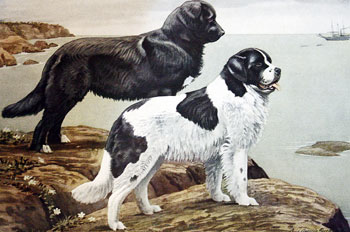Dog Breeds
Dog Tips
Training
Exercise
Medical
Interviews
Miscellaneous
About DB
Contact DB
Resources

Illustration by Louis Agassiz Fuertes
Newfoundland
Two dogs which rival the Eskimo in their ability to endure deep snow and extreme cold are the St. Bernard and the Newfoundland, both of which have become famous as savers of life. Both are well-known subjects of the poet and the painter, who delight to record their heroic deeds or their simple fidelity.
The Newfoundland has the further unique distinction among dogs of being figured on a postage stamp of his native land. He is a wonderful swimmer and is credited with saving many people from drowning.
It is a real pity that this noble, useful, and typically American dog should have lost popularity to such an extent than now he is almost never seen. Only two strains are preserved, so far as can be learned-one in England and one in New Jersey. Therefore it was a great pleasure as well as a great assistance in the making of the plate to meet face to face at the Westminster show of 1918 the straight descendant of the very dog whose photograph had been the artist’s model.
The magnificent St. Bernard carries on better than any other breed in the qualities that characterize the Newfoundland. For many years the breed, which had been perfected and stabilized in England, was used as a farmer’s helper, having the intelligence needed for a herding dog and the weight and willingness to churn and do other real work.
His benignity and unquestioned gentleness made him a very desirable guard and ompanion for children, and his deep voice rather than his actual attack was usually a sufficient alarm against unwonted intrusions. Aside from these fine qualities, however, his mere beauty and staunch dependability should have been sufficient to preserve him from the fate that seems to be almost accomplished.
Weighing from 120 to 150 pounds and standing 25-27 inches at the shoulder, the deep-furred, massive-headed, and kind-eyed Newfoundland was one of the most impressive of dogs. He was a strong, active, and leonine both in looks and in action, having a rolling, loosely knit gait. There were two recognized colors-all black (white toes and breast spot were not defects, however) and white, with large black patches over the ears and eyes and on the body, the latter being known as Landseer Newfoundlands, because a dog of this type is the subject of Sir Edwin Landseer’s well-known painting, “A Distinguished Member of the Humane Society.” The forehead was domed almost to the point of looking unnatural; the bread forehead, deep jaw, flews, and dewlaps betokened a kind and gentle nature.
Did you enjoy this article? Let us know what you think by commenting below. Don't forget to Friend us on facebook and subscribe to our twitter feed to stay updated! Thanks for reading, recommend us to your friends! |